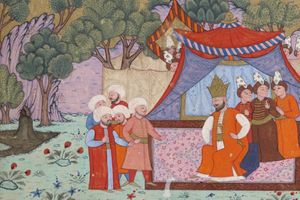Difference between revisions of "Mandate of the Big Yurt"
| Line 20: | Line 20: | ||
|- | |- | ||
|} | |} | ||
| − | '''The Mandate of the Big Yurt''', also referred to as '''Big Yurt politics''', is a common Farfolk ideal of a united Farfolk under a singular benevolent ruler. Despite | + | '''The Mandate of the Big Yurt''', also referred to as '''Big Yurt politics''', is a common Farfolk ideal of a united Farfolk under a singular benevolent ruler. Despite the Subudai being the chief architects of this philosophy: revised renditions by [[House Kharadeen]] or the [[Karamanoğullari]] have seen a more widespread recognition of its legitimacy and viability. |
== The Karamanoğullari Claim == | == The Karamanoğullari Claim == | ||
Revision as of 14:49, 7 November 2020
|
The Mandate of the Big Yurt, also referred to as Big Yurt politics, is a common Farfolk ideal of a united Farfolk under a singular benevolent ruler. Despite the Subudai being the chief architects of this philosophy: revised renditions by House Kharadeen or the Karamanoğullari have seen a more widespread recognition of its legitimacy and viability.
The Karamanoğullari Claim
There is no clear indicator as to why the Karamanoğullari continued to practice Big Yurt politics, even though they had culturally and spiritually grown apart from their Subudai ancestors. The Sermons of Timur Karamanoğlu clarify that their belief in this mandate carries prominent religious connotations within their faith of Kashgarism: as they believe that their direct lineage from their god tasks them to take care of all of its creations. It is a common Karaman conviction that they are destined to rule over the Farfolk, and thus, have never accepted a foreign ruler to be their liege.
This claim finds itself disputed by multiple parties:
